During our tour through Jordan, we made a stop in the rock city of Petra in Jordan. The ancient city is known for its impressive rock formations and architectural masterpieces, including the famous Treasury of Khazne Al-Firaun, the amphitheater, and the Al-Deir Monastery. The city of Petra is also a UNESCO World Heritage Site and one of the most popular tourist attractions in Jordan.
If you haven’t visited Petra, you’ve definitely missed something. For us, visiting the rock city was one of the absolute highlights of our trip. We often couldn’t believe our eyes, were speechless, and simply awed by the scenery and the ruins from times long past. In today’s post, we would like to tell you all about the rock city of Petra in Jordan, show you our highlights, and give you the best tips. Have fun browsing!
You should also know:
- Our best Amman highlights
- Off to the Wadi Rum desert
- Top Jordan attractions
- Jordan Round Trip Tips & Highlights
- You should also know:
- History of the rock city of Petra in Jordan
- Petra was only rediscovered in 1812
- The top sights
- 1. The Dam (Bab Al Siq)
- 2. The Gorge (As Siq)
- 3. The Treasury (Khazne Al-Firaun)
- 4. The Street of Facades
- 5. The Roman Theater
- 6. The Royal Tombs
- 7. The Grand Palace and the Street of Columns
- 8. The Monastery (Monastery Ad-Deir)
- Other Highlights
- Rock City of Petra by Night
- Getting to Wadi Musa
- Booking Accommodation
- Admission and Opening Hours
- Tip: The Jordan Pass
- Best Time to Visit Petra
- Best Time & Travel Tips
- Food Tip in Wadi Musa
- Booking Tours to Petra
- Conclusion on the Rock City of Petra & Video
- FAQ on the Rock City of Petra
History of the Rock City of Petra in Jordan
When we thought of Jordan before our trip, we always had the famous images of the Rock City of Petra in mind, as well as the film “Lawrence of Arabia.” It was clear that we absolutely wanted to explore these highlights. We can hardly put into words how we felt walking through the ruined city and marveling at all the breathtaking buildings. But what is this ruin actually all about? We found the answer in the local museum, online, and in all the brochures:
Petra is considered one of the New Seven Wonders of the World and is a Nabataean ruin site carved into stone and rock. Petra was supposedly permanently inhabited as early as 9000 BC. However, the Nabataeans only arrived in Petra around 500 BC and reportedly carved the first cave dwellings into the rock. Later, the people traded primarily in spices, incense, and silver, becoming very wealthy as a result. Petra was also conveniently located near important trade routes, which was an advantage for traders from near and far. This enabled them to sell their goods here.
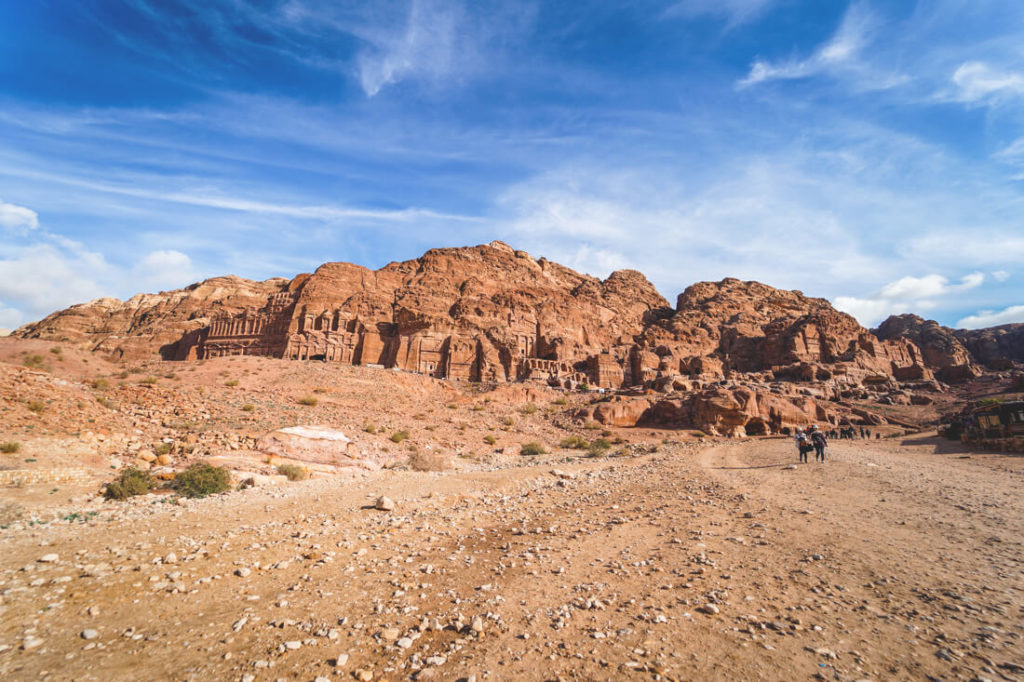
To this day, however, it is not clear how the city originated and was built. The only evidence available here is biblical sources and Roman and Greek records. It is assumed that Petra became the capital of the Nabataeans and that this ruined city experienced its heyday around the 2nd century. At some point, the tents gradually disappeared and permanent buildings were erected. This is how the main temple and other structures came into being. Scientists estimate that around 30,000 to 40,000 people lived in Petra at that time.
Petra was not rediscovered until 1812.
Yet despite its heyday and prosperity, the ruined city of Petra was one day forgotten. The inhabitants abandoned the city, and so the once lively town became a kind of ghost town. The Romans are said to have occupied the city, and later the Arabs. Earthquakes are also said to have hit the city hard, causing people to migrate. In addition, the trade routes were rerouted, which is why Petra was no longer attractive to many. It is assumed that the last inhabitants left the city in the Middle Ages.

For a long time to come, it remained unclear to many whether Petra was merely a figment of the imagination or whether this city actually existed. The Swiss Johann Ludwig Burckhardt (Jean Louis Burckhardt) discovered the ruined city quite by chance in 1812 while on an expedition in the Middle East. Over the years, more and more of Petra was discovered and revealed. Today, it is estimated that just 20 percent of the city has been excavated. So we can stay excited about what else will be discovered in the coming years.
The top sights
The city of Petra awaits you with many great sights and highlights. On the first day, we arrived in the rock city around 11:30 a.m. and leisurely explored the Main Trail from the entrance to the Grand Palace (a little further to the restaurant) and back until 3:30 p.m. On this route, you will pass many highlights and get a great first impression of the rock city.
On the second day, we went on a great hike to the monastery, but more on that later. If you start early in the morning, you can walk to the monastery and back and get a great impression of Petra. Optionally, you can add a second or even third day. Let’s first look at the individual highlights.
1. The Dam (Bab Al Siq)
Directly after the Petra Visitor Center, the path continues straight ahead, while donkeys, camels, and horses roam alongside you on their own track, chauffeuring guests. We ask you to leave the poor animals alone and use your healthy legs instead. Unfortunately, this is still part of the culture and tourism in Jordan. On the path to the gorge, you will pass tombs, the four pyramids, the Djinn blocks, monuments, inscriptions, and statues. By the way, “Bab Al Siq” means something like “Gate to the Gorge.”

2. The Gorge (As Siq)
Then you slowly come to the entrance of the Gorge (As Siq). It is about 1.2 kilometers long and amazed us again and again. The high cliffs and rock formations, shimmering in beautiful red and orange tones, are particularly beautiful. The gorge is the impressive entrance to Petra and you will surely love it as much as we did. We stopped again and again, looked up, and were truly speechless. What nature and humanity have created there is truly unique.

In some places, the gorge is so narrow that you have to make room for a carriage to pass through. Look out for the remains of the aqueducts to your left and right. This is how the Nabataeans once supplied the city with drinking water. Pretty smart, right? In general, the people were very skilled and developed a modern infrastructure even in their time.

3. The Treasury (Khazne Al-Firaun)
It takes just under an hour until you reach one of the city’s highlights, the Treasury (Khazne Al-Firaun). The almost 40-meter-high crypt is particularly impressive due to its beautiful decorations. It is believed that this building was built in the 1st century BC, but no one is certain. The view was simply breathtaking; we couldn’t get enough.

Of course, there are many tourists milling around here, so only with a bit of luck will you get pictures like these where hardly anyone is in sight. Many Bedouins, camels, donkeys, and tour guides also gather here, and they’ll ask if you’d like to be driven or ridden back to the entrance. To your left is a souvenir shop where you can also purchase drinks and snacks.
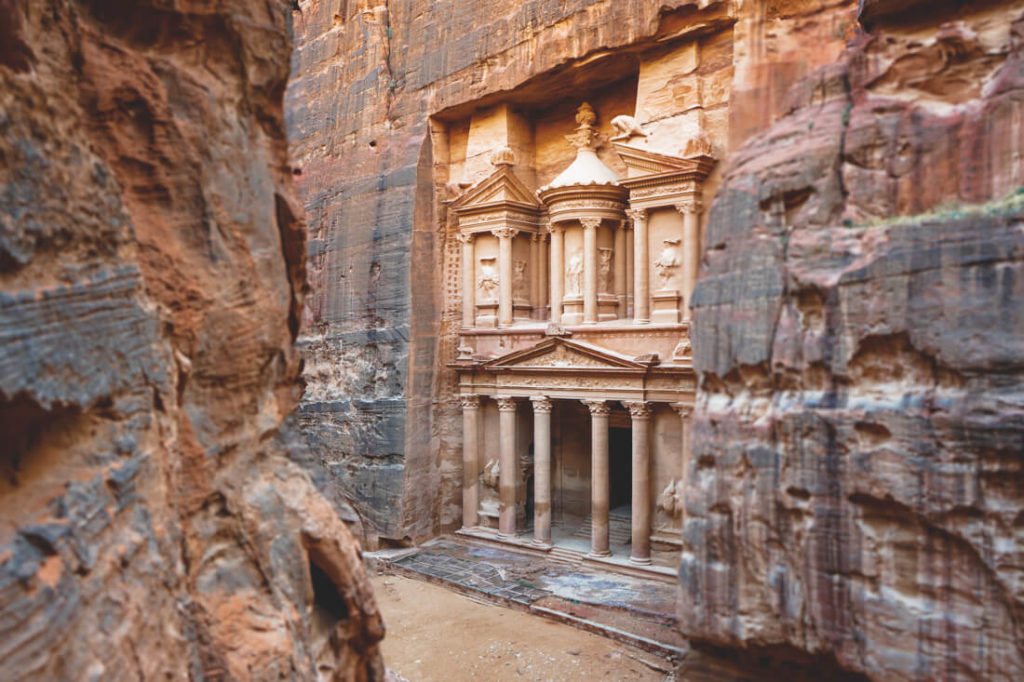
4. The Facade Street
Directly after the Treasury, you come to the Facade Street. Here, Nabataean tombs, carved into the rocks, are lined up closely together. Now the gorge opens up, and you’ll find numerous souvenir stands, restrooms, and small snack restaurants in the valley. You’ll often see police officers here, who are very present in the ancient rock city.

5. The Roman Theater
The walk continues to the Roman Theater, which probably had room for up to 4,000 people. It’s truly astonishing how well preserved the many buildings are even today. Incidentally, it’s the only amphitheater in the world that was carved entirely out of rock.

6. The Royal Tombs
The Royal Tombs (13 tomb temples) hewn into the rock are also very impressive. You will find them on the right side of the wadi, starting with the Urn Tomb, continuing to the Silk Tomb, as well as the façade of the Corinthian Tomb and the Palace Tomb. A path leads you to the tombs, which you can explore individually. Follow the large flag on the hill; there is a bench from where you have a truly beautiful view of the rock city. You can even enter some tombs and admire the beautiful rocks and colors from the inside.
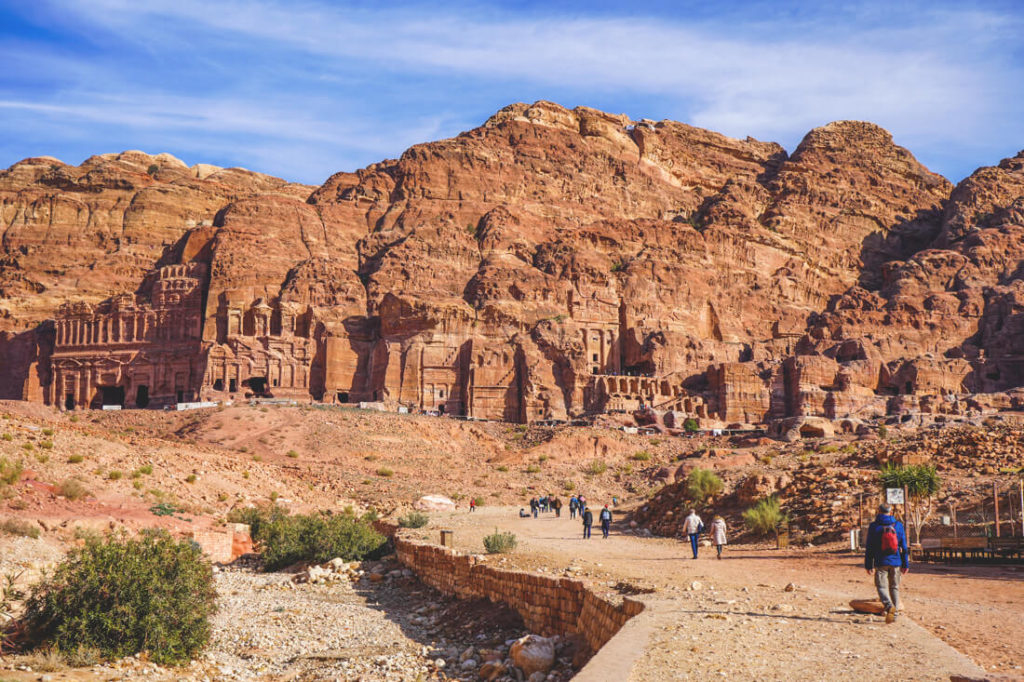
7. The Grand Palace and the Street of Columns
We strolled further and reached the Great Temple via the Street of Columns. The temple’s area is estimated at around 7,500 square meters, making it one of the largest architectural complexes in the ruined city. The stairs take you up to the sacred square, from where you continue up to the actual temple. We climbed all the way to the top and had a fantastic view of the Royal Tombs, the Colonnaded Street, and other ruins. A little further on, you’ll find a restaurant with restrooms (approx. 4 hours round trip).
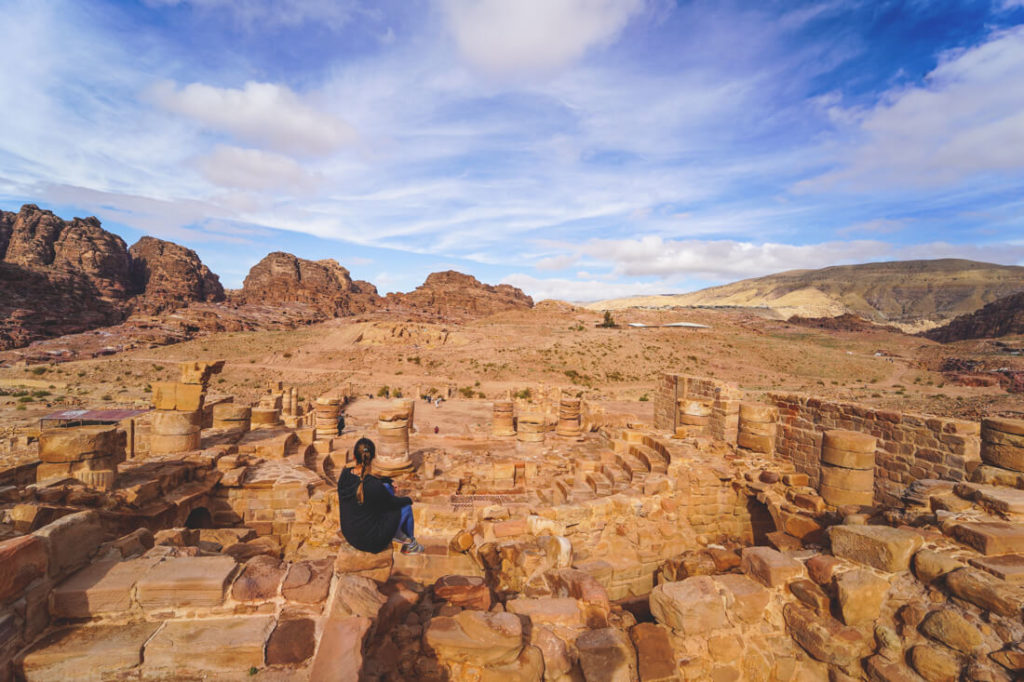
8. The Monastery (Monastery Ad-Deir)
Our absolute highlight was the Ad-Deir Monastery. On the second day, we took a taxi (12-15 JD) to the back entrance of the rock city and hiked for two hours to this beautiful monastery. Relatively early on, you’ll reach a small hut where you have to show your entrance ticket. The hike itself was quite easy and gave us numerous breathtaking views all the way to Wadi Araba. Not many tourists make this tour, so we naturally enjoyed the idyllic setting to the fullest, without any crowds.
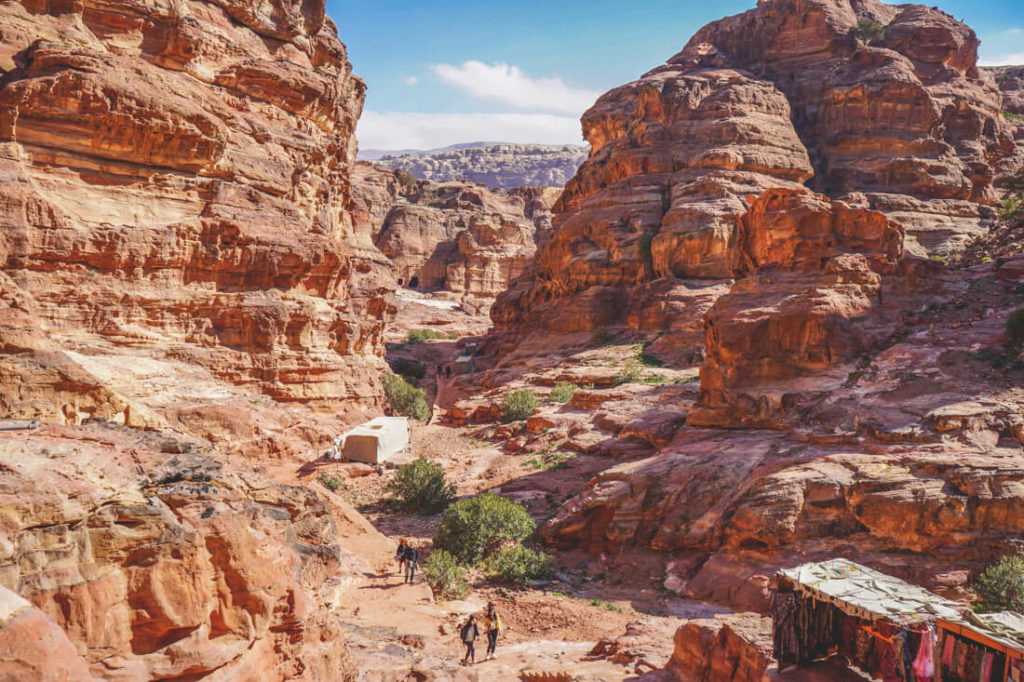
Arriving at the Ad-Deir Monastery, we could hardly believe our eyes. The sight once again left us speechless! This structure is around 47 meters wide and 48 meters high, and was probably carved into the red rock in the 1st century BC. Throughout the surrounding area, you’ll find around 100 other monuments (rock chambers, sacrificial sites, cisterns, etc.), as well as fantastic vantage points of the mountain landscape and the aforementioned Wadi Araba, located 1,000 meters below.
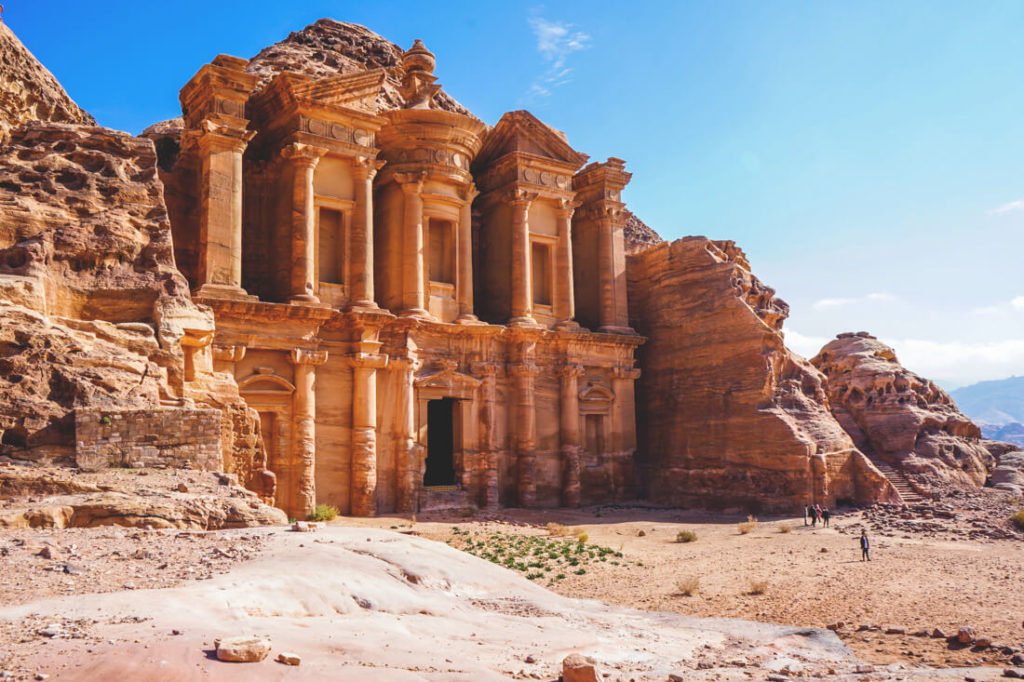
Right in front of the Ad Deir Monastery, there’s a small restaurant (Ad Deir Restaurant) with great seating. Here, we ordered tea (2 Jordanian dinars) and enjoyed the view of the monastery. It’s amazing what the people here once created with their own hands. You’re not allowed inside the monastery itself, but the view from outside is truly stunning. You feel tiny against this backdrop.
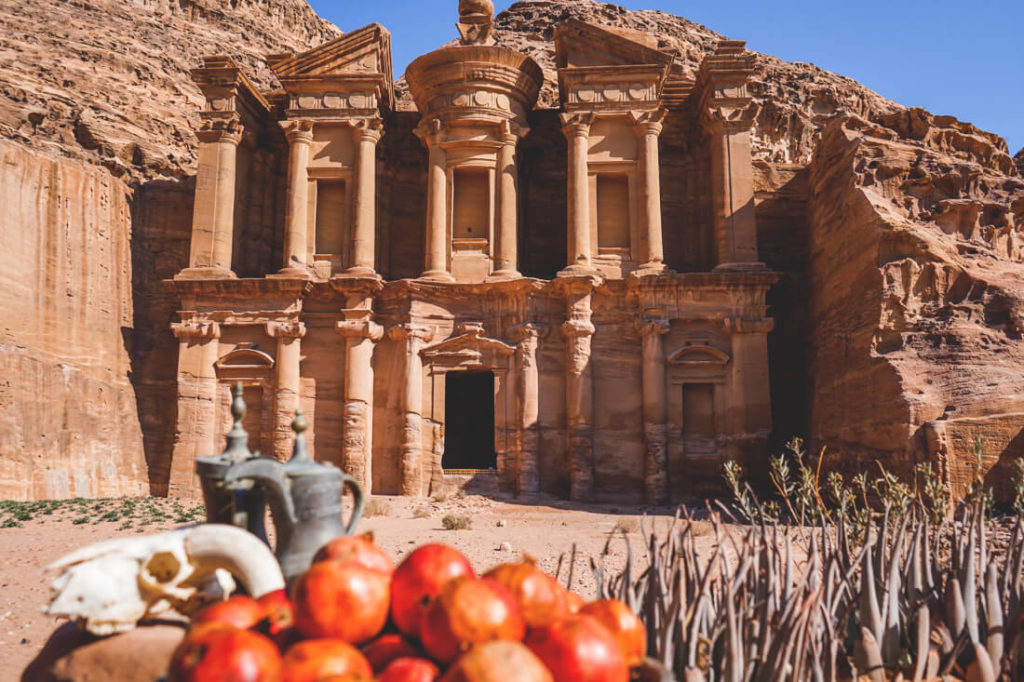
From the monastery, you descend hundreds of steps back to the Grand Palace and the restaurant. Most visitors start at the Petra Visitor Center, walk through the rock city, and then climb the many steps to the monastery. Since we entered from the back entrance, we only had to go down the steps and were back at the visitor center after about two hours. So we did this relaxed one-way tour that day.
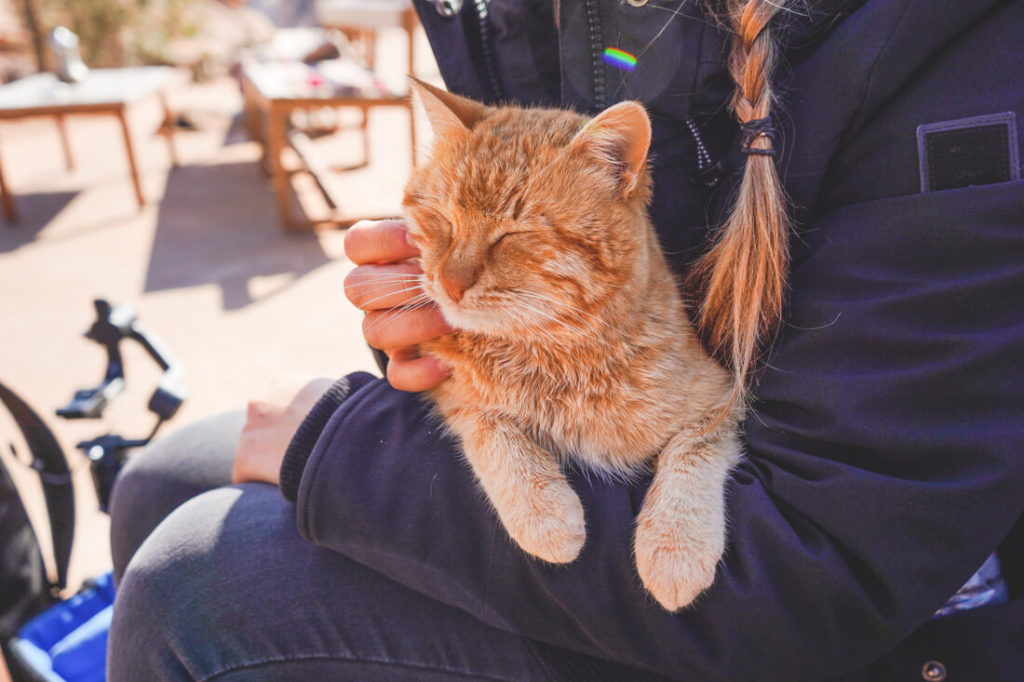
More Highlights
On the map, you’ll quickly see that there are other hiking trails and highlights in the ancient city, such as the church and tombs, the high sacrificial site, the great temple, the lion fountain, and other spots. We found our tours to be sufficient and would recommend them to everyone.
Rock City of Petra by Night
Every Monday, Wednesday, and Thursday, “Petra by Night” takes place in the rock city. It’s best to just google it, then you’ll see what to expect. Around 1,500 candles are placed in front of the Treasury and other parts of the city. Staff also lay out cushions and blankets for people to sit on, tell stories in front of the Treasury, play music, and serve tea.
The entire show lasts around two hours and costs 17 JD per person in addition to the normal day ticket. Meet at the Visitor Center around 8 p.m. before heading through the gorge to the Treasury. You’ll be back at the Visitor Center around 10:30 p.m. Children under 10 are free. We’ve often heard that this event is very crowded.
Getting to Wadi Musa
Car: Wadi Musa is only about 2 hours away from Aqaba. To get there, simply drive straight ahead on the Desert Highway and then on the Kings Highway in your rental car*. From Wadi Rum Village, it’s also just under 2 hours. If you’re coming from Amman, you should plan on about 3.5 hours for the 230 kilometers. The roads are generally well-developed, and you’ll find gas stations at regular intervals on your way to Petra (1 liter = 0.78 JD).
Bus: You can also take the Jett buses. However, you should be aware that they don’t run all the time and only at certain times on certain days. From Amman, the buses depart early in the morning around 6:30 a.m. and from Wadi Musa, they return at 4 p.m. The round trip costs approximately 11 JD. You can find more information here: Jett.com.
Taxi: You can also take a taxi. We photographed the prices on site (as of January 2020). The ride from Aqaba to Petra officially costs 53 JD per taxi, which is quite reasonable for several people. Be sure to negotiate with the driver, as you can usually get a cheaper ride. This also takes you from the capital, Amman, to Petra and back for 30 JD (a local taxi driver offered it to us).
Booking Accommodation
If you also want to see the rock city of Petra in Jordan, we recommend spending the night in Wadi Musa. The city is the perfect starting point for your exploration. The Visitor Center is located right in the city center, from where you can then reach the ruins. It’s worth staying overnight, as you’ll be exploring the complex all day anyway, so it’s hardly worth traveling any further. We first stayed at the Brother Home*, which was okay for one night, and then at the Nomads Hotel in Petra.
We highly recommend the Nomads Hotel in Petra* (€40 per night with breakfast). The accommodations are coolly furnished, with a lobby (foosball table, book corner), a restaurant, a café, a terrace, and a great view of the city and the mountains. The rooms are modern but simply furnished, with a very comfortable double bed, storage space, and a bathroom with a shower. The staff are young and friendly, and the food is also excellent. For 7 JD, you get a full dinner (soup, salad, main course, desserts).
Other well-rated hotels on site:
Admission and Opening Hours
The rock city of Petra in Jordan is open in summer from 6 a.m. to 6 p.m. and in winter from 6 a.m. to 4/5 p.m.. You can purchase entrance tickets at the Petra Visitor Center. You should also pick up the English brochure, as this brochure contains a much more detailed map of the rock city. You can also book a guide to show you the rock city and walk with you to the highlights (but this is quite expensive).

You can only enter the Rock City with a valid ticket. If you stay at least one night in Jordan, you pay 50 JD (63€) for one day, 55 JD (70€) for two days, and 60 JD (76€) for three days. We stayed in the Rock City for two days and found this option ideal. You need your passport to purchase your ticket; children under 12 go free. You can pay on site with cash or by credit card. Please note: If you only want to explore the city as a day tripper (e.g., coming from Israel), you will have to pay 90 JD entrance fee (114€).
Tip: The Jordan Pass
If you hold the Jordan Pass, you won’t pay anything for the rock city of Petra on site, as admission is already included. However, the pass is only worth the price if you enter via Amman (40 JD for the visa) and plan to spend at least two days exploring the rock city. If you enter the country in Aqaba, you don’t pay anything for your visa on arrival and therefore don’t necessarily need the Jordan Pass (only if you visit many other attractions). You should know that the pass is only valid for visitors who stay in the country for at least 3 nights.
- WANDERER PASS for 70 JD (89€) includes 1 day in Petra, free entry to over 40 attractions and a visa fee of 40 JD if you stay in the country for at least 3 nights | Book here.
- EXPLORER PASS for 75 JD (96€) includes 2 days in Petra, free entry to over 40 attractions and a visa fee of 40 JD if you stay in the country for at least 3 nights | Book here.
- EXPERT PASS for 80 JD (102€) includes 3 days in Petra, free entry to over 40 attractions and a visa fee of 40 JD if you stay in the country for at least 3 nights | Book here.
You can purchase the pass online in advance so you can present it upon entry and save on visa fees. After purchase, the pass is valid for 12 months but is not transferable. The pass is activated at the first tourist attraction and is then valid for two weeks. The pass is also valid for: Wadi Rum, Jerash, Aqaba Museum, Kerak Castle, Amman Citadel, Roman Theater in Amman, Ajloun Castle, and much more. Adding everything up, you can save up to €140 if you use the pass in full.
Best Time to Visit Petra
You can visit the rock city of Petra all year round. You should just be aware that the ruined city is often closed in rain and snow. Sudden flooding is not uncommon then. We were very lucky with the weather in January and were able to explore the city under blue skies, 20°C, and sunshine. Another couple was very unlucky a few days later and had to postpone their visit because the weather was really bad.
According to climate tables, the best time to visit the rock city of Petra in Jordan is between March and May and September and November. During this time, the temperatures are pleasant; it is not too hot and not too cold. In the summer months of June to August, it is generally very warm in the country, with temperatures reaching up to 34°C in Wadi Musa. January is the coldest month, which also brings the most rain on average. But you never know, the weather changes quickly.
Best time & Travel Tips
It’s best, of course, to be at the visitor center entrance right at 6 a.m. Very few visitors make their way to the rock city that early in the morning. If you’re lucky, you’ll be able to admire and photograph some of the highlights while they’re still almost deserted. Things also relax in the late afternoon, around 3 p.m. (inside the rock city). Most visitors start between 8 and 10 a.m., which can get really crowded, especially during peak season. However, since the complex is very spacious and large, the rush is certainly bearable.
And another tip if you’re traveling to Petra during the warmer months: It’s best to wear a hat, as it’s supposed to be really hot at that time. You should also bring plenty of drinks, but you can also buy them at the smaller restaurants. Wear comfortable shoes; you’ll be out and about all day. Bring a second battery for your camera, too, as it will be in overdrive with all the scenes here.
Food Tip in Wadi Musa
We highly recommend the restaurant “My Mom’s Recipe,” which we discovered by chance. We ordered fresh, warm bread, oil, spices, hummus, lentil soup, and warm tea. The food was absolutely delicious, and we only paid around €12 for everything. The restaurant is just a 4-minute walk from the Visitor Center and has a Tripadvisor rating of 4.5 out of 5 from more than 1,800 reviews. Not to mention the cool look and the view from the top floor.

Book tours to Petra
You can book guided tours to Petra at GetYourGuide. We’ve selected the best offers for you:
- From Aqaba: Guided Day Tour to Petra*
- Start from AmmanAmman: Guided Day Tour to Petra*
- From Eilat: 2-Day Tour to Petra and Wadi Rum*
- Private Day Tour from Amman to Petra with Pick-up*
- 2-Day Tour of Petra, Jerash, and Amman from Tel Aviv*
Conclusion on the Rock City of Petra & Video
Touristy or not, you have to see this ruined city. We can only repeat ourselves and emphasize again and again how breathtaking these ruins are. So often we were speechless and could hardly believe what people built there so many years ago. It is an indescribable feeling to stroll through the complex and imagine what it must have been like here once. If you come to Jordan, plan at least one day for this highlight.

FAQ Rock City Petra
Where is the rock city of Petra? How much does admission to the rock city of Petra cost? How much time should I allow? Is the Jordan Pass worth it for visiting the rock city of Petra? When is the best time to travel to the rock city of Petra? How safe is a trip to Jordan?